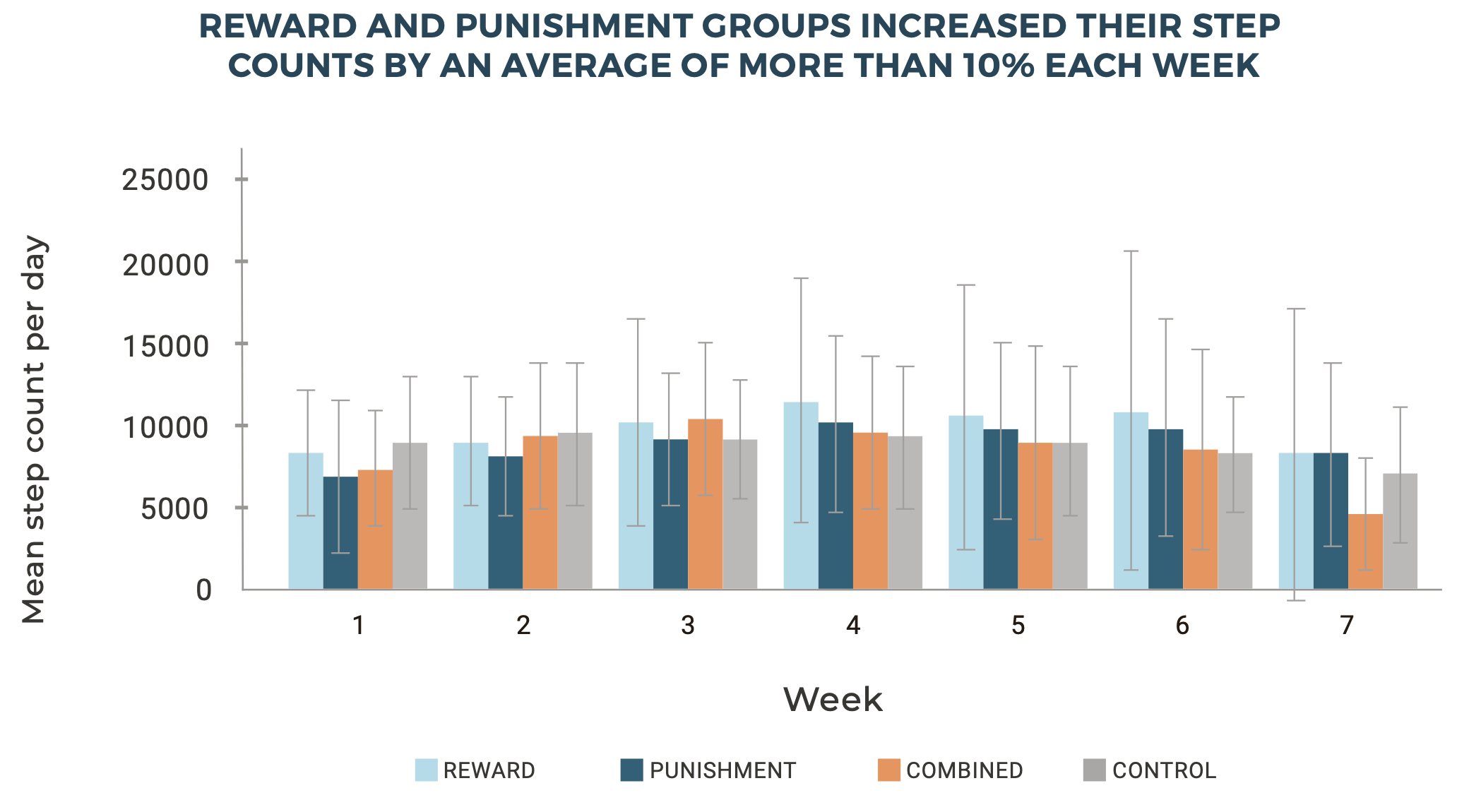Pattern Health has developed and tested a variety of behavioral strategies to increase user engagement and adherence to these programs in collaboration with Dan Ariely’s Center for Advanced Hindsight at Duke University, including the following case study.
How to best incentivize exercise: Gaining points, losing points, or both?
In spite of the proliferation of wearable activity trackers, physical activity remains at an all-time low. Recent evidence from a large randomized controlled trial suggests that wearing an activity tracker alone, without supplementation of other behavior change techniques, may be ineffective for increasing step counts or moderate-to-vigorous physical activity. However, pairing these technologies with behavioral science-based interventions may hold the promise that wearables on their own haven’t been able to deliver.
We tested a points-based financial incentive system where participants could a) earn points for physical activity (which were redeemed for cash at the end of the study), b) lose pre-awarded points that corresponded to the total amount attainable, or c) both gain points when meeting goals and lose points when not meeting goals. We hypothesized that when points were framed in terms of losses (where people would start with points that they could lose if they didn’t hit their physical activity goal), they would achieve greater physical activity than when a points-based system was framed in terms of gains (where people would earn points if they did hit their step goal. The final “combined” condition had the advantage of loss aversion in the “loss” condition as well as the friendlier approach of the “gain” condition, but we predicted that the mixed message would not be as strong as the pure loss condition.
Participants were randomly assigned to one of these four intervention groups: Reward, Punishment, Combined, or Control. The intervention consisted of a points-to-cash system in which, depending on the condition, points were earned, lost, or both, based on meeting a daily step-count goal tailored to the activity level of each participant. Step goals were assigned based on baseline level of activity in Week 1, and gradually increased over time when participants met their step goals. The points were then exchanged for money after the study, with 6 points being valued at $1 USD. All participants downloaded the Pattern Health mobile application and were given Fitbit devices to track their physical activity for the seven weeks of the study, during which participants were given personally tailored step goals that dynamically increased each week.
The loss-frame group was found to be most effective at increasing adherence to step-count goals, with loss-frame group participants achieving their step goals on 53% of days. By the final week of the intervention, 36% of the loss-frame group was achieving an average of more than 10,000 steps per day, an increase from just 7% at baseline. Adherence was determined by calculating the proportion of days per week in which the step-count goal was met (e.g., if the step-count goal was met an average of 3 out of 7 days in a week for a condition, then that condition’s adherence was 42.8%).

The mean increases in steps per week were 13.84%, 10.73%, 5.34%, and 0.47%, for the Reward, Punishment, Combined, and Control groups, respectively. In other words, the Reward and Punishment groups increased their step counts by an average of more than 10% on average each week throughout the intervention. Further, the mean improvement from Week 1 to Week 7 was 1425 steps per day for the Punishment group, compared to -75 steps per day for the Reward group, -2751 steps per day for the Combined group, and -1944 steps per day for the Control group. All treatment groups had better overall adherence than the Control group.
On top of the adherence results, participants felt that the points-to-cash economy was motivating, it accurately reflected activity, and was fair. This is important because even if an intervention is highly effective, it will not result in physical activity improvement if people are not willing to use it. Most participants (95%) opened the app on at least 80% of the days throughout the intervention. Participants liked the app and perceived the app as motivating. Half (50%) of the sample rated the motivational value of the app at an “8” or higher on the 10-point scale with 10 being “very motivating”.
Interestingly, the Combination group started the intervention with the most adherence; participants in this group met their step goal 78.5% of the days in the second intervention week, the first week following baseline. By week 4 (three weeks after baseline), however, the Combination intervention became less effective than the Loss-frame group, indicating that the combination of gain and loss frames may not be a sustainable strategy for promoting increased physical activity.